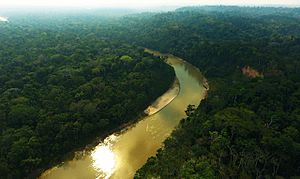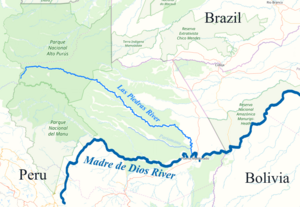Las Piedras River (Peru) facts for kids
Quick facts for kids Las Piedras River |
|
|---|---|

Drone photo from lower Las Piedras River
|
|
 |
|
| Other name(s) | Río Tacuatimanu |
| Country | Peru |
| Physical characteristics | |
| River mouth | Madre de Dios River |
| Length | 640 km (400 mi) |
The Las Piedras River (also known as the "River of Stones") is a very important river in the southeast Amazon region of Peru. It is a major tributary (a smaller river that flows into a larger one) of the Madre de Dios River.
Contents
Exploring the Las Piedras River Region
The Las Piedras River is found in the Madre de Dios department of Peru. This area is known as the official capital of biodiversity in Peru. It is also part of the Tropical Andes Biodiversity Hotspot. A "biodiversity hotspot" is a place with a huge number of different plants and animals, many of which are found nowhere else on Earth.
The Piedras River is the longest river that flows into the Madre de Dios River. Most of its water comes from the lowlands of the Amazon, below 400 meters (about 1,300 feet) in height. The main town in the Las Piedras District is Planchón. It is located in the Tambopata province.
Protected Areas Along the River
Large parts of the Las Piedras River's upper sections are protected. These areas include the Alto Purus National Park. This park helps keep the natural environment safe.
Further down the river is the Reserva Territorial Madre de Dios. This is a special territory for the Masco-Piro indigenous people. They have chosen to live in voluntary isolation, meaning they have little or no contact with the outside world. This way of life has continued since the 1860s.
Other areas along the river include places where companies can harvest timber. There are also indigenous territories like Monte Salvado and Puerto Nuevo. Closer to the river's mouth, you can find areas for harvesting Brazil nuts. There are also small communities of indigenous people and mestizos (people of mixed heritage), such as Lucerna and Sabaluyoc.
Conservation Efforts in the Region
Several groups are working to protect the Las Piedras River area. These include private conservation areas like the Las Piedras Amazon Center (LPAC). This center covers 4,460 hectares or 11,000 acres and is run by a Peruvian non-profit called ARCAmazon. Other groups like Arbio Peru and Jungle Keepers also protect land. Hoja Nueva, a non-profit from the US, also helps protect this important region.
A Look at the History of the Piedras River
The original name for the Piedras River, given by the indigenous people, was “Tacuatimanu.” The region is home to several indigenous groups, including the Masco-Piro, Amahuaca, and Yine.
The Rubber Boom Era
In the late 1800s, a period called the "rubber boom" began in the Las Piedras area. This happened because a lot of high-quality rubber was found there in 1894. During this time, rubber barons (wealthy business owners) exploited and enslaved many Masco-Piro and Amahuaca people.
Some Masco-Piro people living in isolation today are thought to be descendants of those who escaped the rubber barons. They either fled into the forests to avoid being enslaved or after fighting back against mistreatment. The rubber boom in the Las Piedras River ended around 1912.
Indigenous Communities and Their Languages
The Masco-Piro language is part of the Arawak language family. The Amahuaca language is part of the Pano family. The Masco-Piro are semi-nomadic, meaning they move around seasonally. They are believed to travel between the upper parts of the Manu, Alto Púrus, and Las Piedras rivers.
The Amahuaca people live in the community of Boca Pariamanu. Some also live in isolated communities in the upper Piedras River. The Yine people live in the Monte Salvado indigenous territory. This area is near the Reserva Territorial Madre de Dios. The Yine of Monte Salvado arrived from another part of Peru around 1994.
Changes in Land Use Along the River
In recent years, new developments have affected the forests and wildlife of the Piedras region. One major change was the paving of the nearby Interoceanic Highway. This highway project cost a lot of money and improved many roads and bridges. It now allows continuous travel and shipping of goods between ports in Brazil and Peru.
Impact of the Interoceanic Highway
The full effects of the highway are still being seen. However, parts of the lower and middle Las Piedras River are now at a higher risk of deforestation. Deforestation means clearing forests for other uses. This is because in nearby Brazil, paved highways have caused forest changes up to 45 kilometers (about 28 miles) away. Some parts of the Piedras River are within 30 kilometers (about 18 miles) of the highway.
Besides logging, farming and ecotourism are important industries in the Piedras watershed. Brazil nuts are also a major product. Recent changes to forestry laws might be leading to more wood being harvested, even in areas meant for Brazil nut collection.
Conservation Efforts Against Deforestation
Since 2013, areas near the Las Piedras Amazon Center (LPAC) have continued to experience deforestation. However, LPAC itself has been protected. This is thanks to the hard work of the Peruvian non-profit ARCAmazon. The main reasons for forest clearing around LPAC and the community of Lucerna are for growing cacao and raising cattle. Since 2013, 605 hectares (1,490 acres) of forest have been cleared in the wider area.
Amazing Plants and Animals
The Las Piedras watershed is a home for many different kinds of animals and plants. It is a very important place for biodiversity.
Endangered Species and Other Wildlife
Some of the special animals found here include the endangered Peruvian spider monkey and the giant river otter. These animals need protection to survive. Other animals that have been seen in the watershed include giant anteaters, jaguars, and ocelots.
Clay Licks: A Natural Gathering Spot
The river area also has "clay licks." These are special places where birds and animals gather to eat clay. The clay contains important minerals like sodium that they need for their health. It's like a natural supplement bar for wildlife!
Tributaries of the Piedras River
The Las Piedras River has many smaller rivers and streams that flow into it. These are called tributaries. Some of them include:
- Ceticayo
- Chanchamayo
- Curiacu
- Huasca
- Panguana
- Pingachari
- Pumayacu
- Ronsoco
- Ronsoquito
- San Francisco
- Panguamayo
- Shahuana
- India
- Boleo
- Pariamanu
Representation in Media
- The river is featured in a book by conservationist and explorer Paul Rosolie. The book is called Mother of God: An Extraordinary Journey into the Uncharted Tributaries of the Western Amazon (2014).
Images for kids
See also
 In Spanish: Río Tacuatimanu para niños
In Spanish: Río Tacuatimanu para niños





